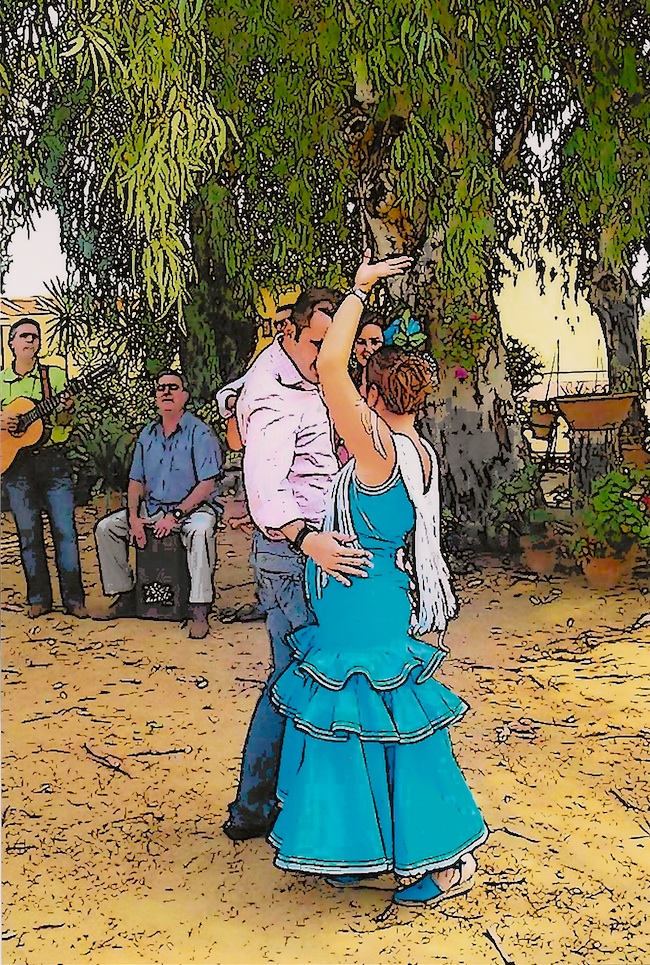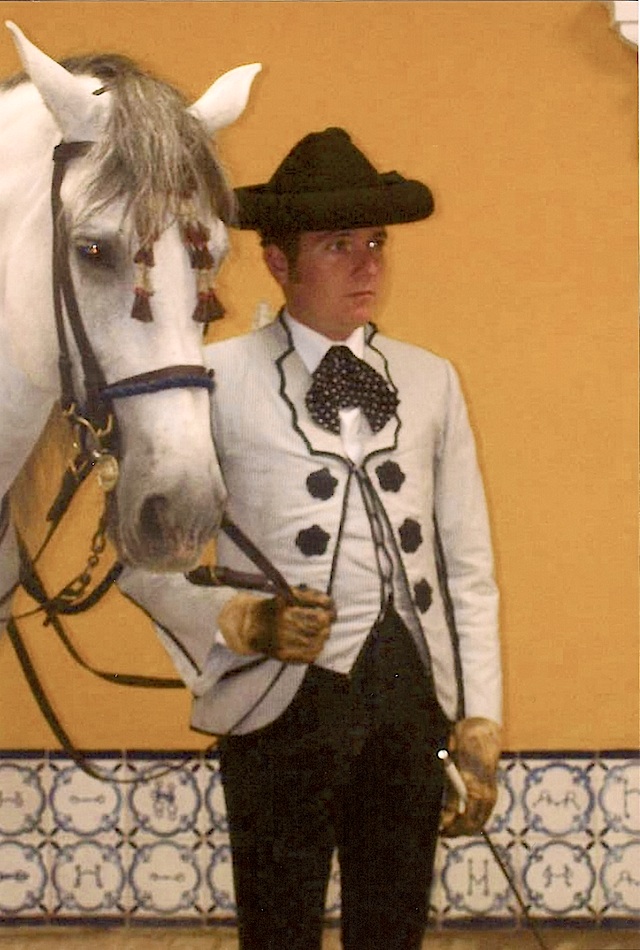
|
|
 |
||||||||||||||||||||
|
|
|||||||||||||||||||||
|
SPANISH DANCERS Andalusian Warhorses are Transformed into Beings of Grace & Beauty in Southern Spain By Erin Caslavka The lights in the arena dim as flamenco music fills the air, castanets punctuating the beat of the song. I sit in my bleacher seat surrounded by hundreds  of other visitors to the arena, their hand-held fans waving in the midday heat like a thousand monarchs’ wings, in restless anticipation of the show we are about to watch: Como Bailan los Caballos Andaluces (“How the Andalusian Horses Dance”). of other visitors to the arena, their hand-held fans waving in the midday heat like a thousand monarchs’ wings, in restless anticipation of the show we are about to watch: Como Bailan los Caballos Andaluces (“How the Andalusian Horses Dance”).I’d arrived in the Andalusian city of Jerez de la Frontera during a tour through Southern Spain, where the Fundacion Real Escuela Andaluza del Arte Ecuestre (the Royal Andalusian School of Equestrian Art) is located. Early in the week, I’d spent some time learning about the local customs and traditions, including a brief lesson in flamenco dancing at a nearby ranch that welcomes visitors. As I’d passed through the fertile fields where olive trees grow in abundance and vaqueros ride the hills overseeing cattle-ranching operations, it seemed to me the perfect location for the training and education of both riders and horses. Schooled in the art of dressage (the guidance of a horse through a series of complex maneuvers using slight shifts in a rider’s weight, hand or leg movements), the horses in training here are Andalusians. Particularly adept at following commands, they’ve been bred to be docile enough to take instruction, yet fiery enough to carry themselves with pride. The Andalusian has a fascinating history: Over 3,000 years ago, horses from the Iberian peninsula were well known as superior warhorses because of their strength and agility.  The Romans used them to pull their chariots, and Julius Caesar wrote of their talents on the battlefield. Hannibal relied on them (as well as on elephants) to help him cross the Alps into Italy in 218 B.C. The Romans used them to pull their chariots, and Julius Caesar wrote of their talents on the battlefield. Hannibal relied on them (as well as on elephants) to help him cross the Alps into Italy in 218 B.C.In 1493, Spain passed a law that made it mandatory for every ship leaving the country to have at least a dozen native horses onboard. As a result, almost 80% of all modern breeds in former Spanish lands can trace a part of their lineage to the Spanish horses’ bloodlines. Of those native horses, the Andalusian became the premier warhorse of Spain, and in many ways it carried Spain to greatness during its years of conquest. As they enter the arena at the Real Escuela, the magnificent white horses are indeed stunning to behold. The Real Escuela uses humane methods to train them for as long as seven years before they are ready to perform. Having passed through this rigorous training period, the Andalusians I’m watching today confidently stride into the theater carrying riders who wear costumes evocative of  clothing worn in the 18th and 19th centuries. For their part, these horses are known as the Andalusian Carthusians, believed to have descended from Andalusians bred by monks at a Carthusian Monastery during the 15th century. clothing worn in the 18th and 19th centuries. For their part, these horses are known as the Andalusian Carthusians, believed to have descended from Andalusians bred by monks at a Carthusian Monastery during the 15th century.I watch as the snow-colored equines are led through a choreographed “dance” set to classical music. The riders hold the reins in one hand and take the horses around the ring, changing the rhythm, speed or direction of the horse with almost imperceptible commands. Stepping hoof-over-hoof in a sideways parade, or kicking their legs straight out in front of them like high-stepping dandies, the synchronized movements of the Andalusians are beyond impressive. Just as I’ve begun to appreciate the hard work and training that have led the horses and their riders to the pinnacle of this intricate, synchronized performance, a rider walks into the arena leading his horse by the reins. Stopping in the middle of the track, the horse stands as a solitary figure of pure muscle, beauty and intellect. Then, this most elegant of animals jumps up from the ground, defying the gravity that pulls at his 1500 lbs. of sheer mass. And in midair, he kicks - extending his legs out in front and behind. After landing on its feet, the horse immediately jumps again, this time bringing its legs in,  clicking all four hooves together beneath its belly. clicking all four hooves together beneath its belly.By the time the horses have finished performing, there isn’t a soul in the arena unmoved by the skill and dedication of the performers: two- and four-legged. Once more, the horses of Spain have upheld their place of honor. FAST FACTS Royal Andalusian School of Equestrian Art Avenida Duque de Abrantes, S/N 11407 Jerez de la Frontera, Cadiz Spain 956-319-635 www.realescuela.org Informational websites for the Andalusian region www.guiadecadiz.com www.andalucia.com Photo credits: Erin Caslakva; iStockphoto.com; GuiadeCadiz.com |
|
|
|
|
| Site Map |